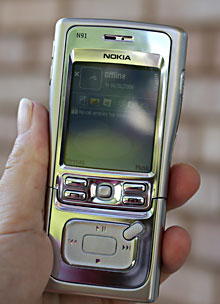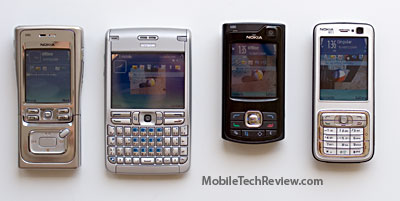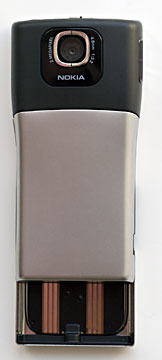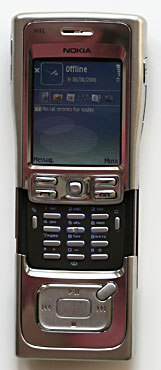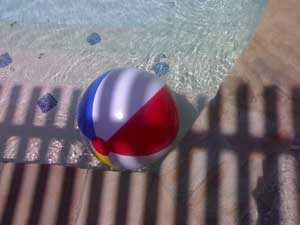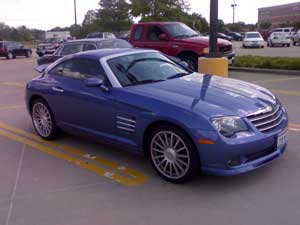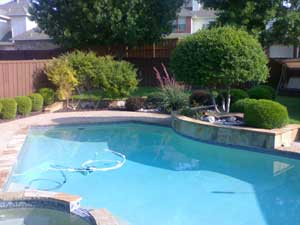
|
||||||||||
Display Unlike several recent high end Nokia S60 3rd edition smartphones, the N91 does not have a particularly high resolution display. It maintains the same 176 x 208 pixel resolution found on older Series 60 phones like the Nokia 6682 and Nokia 7610. Like the 6682 it's capable of displaying 262,000 colors (18 bit) and is bright and easy to read both indoors and out. That said, it looks a bit grainy compared to the N80 and N73 which have much higher resolution displays and you'll be doing more scrolling when web browsing on the N91, which is a shame given the integrated WiFi and excellent web browser. Keep in mind that if Nokia added a high resolution display to this already feature-packed phone the price would probably have gone up considerably. Music When you're talking about a smartphone with so many features it's easy to forget music, which is the Nokia N91's raison d-etre. The phone can hold approximately 1,000 songs and supports just about every major format including MP3, AAC, AAC+, eAAC+, Real, WAV, WMA and M4A. Thus it can handle iTunes (and there's a Mac plugin for syncing to iTunes) formats except songs purchased from Apple's iTunes store (Apple does not share their DRM with anyone). The Nokia can sync to Windows Media Player 10 under Windows and it can act as a mass storage device when connected via USB cable if you prefer to drag and drop your songs to the Nokia. You can transfer Windows Media Player 10 files with DRM (Open Mobile Alliance protection) using Windows Media Player 10 on the desktop to transfer the files over USB.
The music player supports playlists, shuffle, repeat and it will automatically pause music playback should a call come in. The music will resume when you hang up. As mentioned, the front music player controls handle all the basics and work even if you've slid it down to reveal the number pad below. Sound out through the included stereo earbud headphones is very good and for a real treat, hook up your own stereo headphones. Most phones, even high end ones, don't quite reach the iPod's sound quality but the N91 is one of the few that does. Like many recent S60 phones, the N91 has Nokia's Visual Radio which is an FM radio which supports station presets and sounds pretty good. The auto seek function will pass quite a few stations by, so use manual seek to find your favorite stations. The headphones act as an antenna for the radio, so you'll only be able to play radio through them and not the speaker. Horsepower and Performance The N91 runs Nokia's S60 3rd Edition software on Symbian OS 9.1 which offers multitasking, good security and increased speed compared to older Series 60 devices. The phone has 15 megs of shared flash memory and the 4 gig hard drive for storage. It multitasks well and isn't plagued by out of memory issues even when concurrently running the web browser and music player. We benchmarked the phone using FutureMark's SPMarkJava06 (a Java application that benchmarks the Java VM performance which is an indication of the phone's processing power, and both 2D and 3D performance). The N91 managed an SPMarkJava score of 1804, and benchmarked similarly to the Nokia E61, N73 and N80. S60 3rd Edition marks some major changes and older applications written for Series 60, S60 and S60 2nd Edition phones won't work on the Nokia N91. You'll need to get 3rd Edition compatible applications and currently there aren't too many 3rd party apps out there since 3rd Edition is so new. Camera Though it can't compete with the Nokia N93, N80 and N73, the N91's camera is still better than most camera phones offered by US carriers. The 2 megapixel camera can take photos at a maximum resolution of 1600 x 1200 as well as smaller sizes. It can also shoot video with audio at a max resolution of 352 x 288 and it supports 3GP and MPEG4 formats. Surprisingly there's no flash, so don't expect much in poorly lit environments (though the LED flash used on camera phones offers little help anyway). The camera isn't as consistent on exposure and white balance as its 3MP brethren, and we noticed that 3 outdoor shots taken of the same subject within 2 minutes yielded a nice shot, a whited-out over-exposed shot and one with a distinct color cast. So shoot a few frames to make sure you capture a pleasing image. The camera will generally turn out a good shot in amenable conditions (moderate lighting, no fast moving subjects). Overall, color balance is good with a bit of a cool (blue) bias but nothing to complain about. Still images have more noise than the N80 and N73, even in good lighting but it's less than the once flagship Nokia N90. Software and Syncing Nokia's software bundle is very similar across S60 v3 phones, so you'll notice similarity between our reviews in this section. Since it's a smartphone, you can add 3rd party software made for S60 3rd Edition. Though 3rd Edition is still new and the software selection isn't yet broad, but thankfully Nokia includes most everything you need such as strong PIM applications, media players, image editors, voice recorder, a world clock, and more. Contacts has support for pretty much every field found in MS Outlook and groups, while the calendar has alarms, repeat events, day, week and month views. S60 also has notes and Tasks both of which sync to MS Outlook. For fun, the phone comes with Nokia's LifeBlog which helps organize your photos and videos chronologically, like a diary or blog. You can add comments, delete photos that you don't want and sync them to LifeBlog on Windows (sadly there's no Mac version of this cool desktop application). The N91 doesn't come with MS Office viewers or editors, but should you need those you can purchase them separately (QuickOffice is the #1 choice). The N91 comes with a software CD containing PC Suite 8.6 and LifeBlog 2. Always check for the latest versions of those applications, which you can download for free from Nokia's web site. PC Suite is an impressive one-stop application these days, and it far surpasses MS ActiveSync for Windows Mobile and even Palm Desktop. You'll use it to sync your Calendar, Contacts, Notes and Tasks to and from Outlook, browse the phone, send multimedia files, use the phone as a wireless modem and more. It supports connection over the included mini USB cable and Bluetooth. The phone supports three different USB modes: Media Player, PC Suite and Data Transfer (the phone acts as a mass storage device like a USB drive). WiFi and Bluetooth Though the phone's relatively low resolution display doesn't lend itself to power web-browsing, WiFi has its place in smartphone land. The browser is very capable as is the included email client. And WiFi's high speeds are a good consolation for those of us who are using the N91 in the US where we can't take advantage of the phone's 3G capabilities. We suspect the real reason Nokia included WiFi on the N91 was for music sharing over home networks. The smartphone supports WEP encryption (64 and 128 bit), WPA and 802.1x and has a site survey feature so you can scan for available access points. Connections are reliable and range is comparable to PDAs. Battery life takes a hit when using WiFi, similar to other PDA phones. Use WiFi for an hour per day and you'll be fine... several hours WiFi use per day warrants a trip to the charger or a spare battery. The Nokia N91 has a Bluetooth 1.2 with support for headset, handsfree, DUN, FTP, HID (primarily for keyboards), Basic Printing Profile, Object Push profiles and more. As usual for Nokia, the phone paired easily with a Mac, Windows XP PC, and worked well with a variety of popular Bluetooth headsets. While some phones work well with a subset of popular headsets, the Nokia generally works well with most any decent quality headset on the market. Conclusion If you're looking for a triple convergence device that marries a portable music player, phone and PDA the Nokia N91 is worth a look. It's attractive, stable, has great call quality and phone features and good syncing to desktops. The web browser is excellent, though the relatively low screen resolution prevents it from living up to its potential and the email client is reliable with business class features (though no push email). To top it off, the phone has a very good camera and nice imaging applications. And don't forget that 4 gig hard drive! The only drawbacks are the N91's size, weight and price tag. But it's certainly lighter, smaller and cheaper than purchasing and carrying 3 separate devices. Web site: www.nokia.com
| ||||||||||
